Development, Analysis, and Sensory Evaluation of Improved Bread Fortified with a Plant-Based Fermented Food Product
Abstract
1. Introduction
2. Materials and Methods
2.1. Product Description
2.2. Experimental Design
2.3. Ingredients and Preparation
2.4. Bread Production
2.5. Bread Physical Properties
2.6. Protein Content
2.7. Bread Quality Attributes
2.8. Digital Analysis of Bread Crumb Structure
2.9. Sensory Evaluation by Consumer Panelists
2.10. Processing of Data and Statistical Analysis
3. Results and Discussion
3.1. Effect of FFP on Bread Physical Properties and Color Attributes
3.2. Effect of FFP on Bread Quality Attributes
3.3. Effect of FFP Replacement Level on Bread Protein Content
3.4. Image Analysis of Experimental Breads
3.5. Consumer Sensory Study of Experimental Breads
3.6. Further Research
4. Conclusions
Supplementary Materials
Author Contributions
Funding
Data Availability Statement
Acknowledgments
Conflicts of Interest
References
- Borresen, E.C.; Henderson, A.J.; Kumar, A.; Weir, T.L.; Ryan, E.P. Fermented Foods: Patented Approaches and Formulations for Nutritional Supplementation and Health Promotion. Recent Pat. Food. Nutr. Agric. 2012, 4, 134–140. [Google Scholar] [CrossRef] [PubMed]
- Dueñas, M.; Muñoz-González, I.; Cueva, C.; Jiménez-Girón, A.; Sánchez-Patán, F.; Santos-Buelga, C.; Moreno-Arribas, M.V.; Bartolomé, B. A Survey of Modulation of Gut Microbiota by Dietary Polyphenols. Biomed Res. Int. 2015, 2015, 850902. [Google Scholar] [CrossRef] [PubMed]
- Martirosyan, D.; Miller, E. Bioactive Compounds: The Key to Functional Foods. Bioact. Compd. Health Dis. 2018, 8, 36–39. [Google Scholar] [CrossRef]
- Granato, D.; Barba, F.J.; Bursać Kovačević, D.; Lorenzo, J.M.; Cruz, A.G.; Putnik, P. Functional Foods: Product Development, Technological Trends, Efficacy Testing, and Safety. Annu. Rev. Food Sci. Technol. 2020, 11, 93–118. [Google Scholar] [CrossRef] [PubMed]
- Peng, M.; Houser, A.K.; Rahaman, S.O.; Padilla, J.; Anderson, M.; Akmel, A.; Truong, A.; Bhatti, J.; Biswas, D. Effectiveness of probiotics, prebiotics, and prebiotic-like components in common functional foods. Compr. Rev. Food Sci. Food Saf. 2020, 19, 1908–1933. [Google Scholar] [CrossRef] [PubMed]
- Leroy, F.; De Vuyst, L. Fermented food in the context of a healthy diet: How to produce novel functional foods? Curr. Opin. Clin. Nutr. Metab. Care 2014, 17, 574–581. [Google Scholar] [CrossRef] [PubMed]
- Wan, M.L.Y.; Ling, K.H.; El-Nezami, H.; Wang, M.F. Influence of functional food components on gut health. Crit. Rev. Food Sci. Nutr. 2019, 59, 1927–1936. [Google Scholar] [CrossRef]
- Melini, F.; Melini, V.; Luziatelli, F.; Ficca, A.G.; Ruzzi, M. Health-Promoting Components in Fermented Foods: An Up-to-Date Systematic Review. Nutrients 2019, 11, 1189. [Google Scholar] [CrossRef]
- Ivanovski, B.; Seetharaman, K.; Duizer, L.M. Development of Soy-Based Bread with Acceptable Sensory Properties. J. Food Sci. 2012, 77, 71–76. [Google Scholar] [CrossRef]
- Menon, L.; Majumdar, S.D.; Ravi, U. Development and analysis of composite flour bread. J. Food Sci. Technol. 2015, 52, 4156–4165. [Google Scholar] [CrossRef]
- Serra-Majem, L.; Bautista-Castaño, I. Relationship between bread and obesity. Br. J. Nutr. 2015, 113, S29–S35. [Google Scholar] [CrossRef]
- Prieto-Vázquez del Mercado, P.; Mojica, L.; Morales-Hernández, N. Protein Ingredients in Bread: Technological, Textural and Health Implications. Foods 2022, 11, 2399. [Google Scholar] [CrossRef]
- Dimidi, E.; Cox, S.R.; Rossi, M.; Whelan, K. Fermented Foods: Definitions and Characteristics, Impact on the Gut Microbiota and Effects on Gastrointestinal Health and Disease Eirini. Nutrients 2019, 11, 1806. [Google Scholar] [CrossRef]
- Koistinen, V.M.; Mattila, O.; Katina, K.; Poutanen, K.; Aura, A.-M.; HanhinevaVille, K. Metabolic profling of sourdough fermented wheat and rye bread.pdf. Sci. Rep. 2018, 8, 5684. [Google Scholar] [CrossRef]
- Bautista-Castaño, I.; Serra-Majem, L. Relationship between bread consumption, body weight, and abdominal fat distribution: Evidence from epidemiological studies. Nutr. Rev. 2012, 70, 218–233. [Google Scholar] [CrossRef]
- De La Fuente-Arrillaga, C.; Martinez-Gonzalez, M.A.; Zazpe, I.; Vazquez-Ruiz, Z.; Benito-Corchon, S.; Bes-Rastrollo, M. Glycemic load, glycemic index, bread and incidence of overweight/obesity in a Mediterranean cohort: The SUN project. BMC Public Health 2014, 14, 1091. [Google Scholar] [CrossRef]
- Costabile, A.; Santarelli, S.; Claus, S.P.; Sanderson, J.; Hudspith, B.N.; Brostoff, J.; Ward, J.L.; Lovegrove, A.; Shewry, P.R.; Jones, H.E.; et al. Effect of Breadmaking Process on In Vitro Gut Microbiota Parameters in Irritable Bowel Syndrome. PLoS ONE 2014, 9, e111225. [Google Scholar] [CrossRef]
- Burton, P.M.; Monro, J.A.; Alvarez, L.; Gallagher, E. Glycemic Impact and Health: New Horizons in WhiteBread Formulationsformulations. Crit. Rev. Food Sci. Nutr. 2011, 51, 965–982. [Google Scholar] [CrossRef]
- van Buren, L.; Dötsch-Klerk, M.; Seewi, G.; Newson, R.S. Dietary Impact of Adding Potassium Chloride to Foods as a Sodium Reduction Technique. Nutrients 2016, 8, 235. [Google Scholar] [CrossRef]
- Allison, A.; Fouladkhah, A. Adoptable Interventions, Human Health, and Food Safety Considerations for Reducing Sodium Content of Processed Food Products. Foods 2018, 7, 16. [Google Scholar] [CrossRef]
- Mohamed, A.A.; Rayas-Duarte, P.; Shogren, R.L.; Sessa, D.J. Low carbohydrates bread: Formulation, processing and sensory quality. Food Chem. 2006, 99, 686–692. [Google Scholar] [CrossRef]
- Alzuwaid, N.T.; Pleming, D.; Fellows, C.M.; Sissons, M. Fortification of durum wheat spaghetti and common wheat bread with wheat bran protein concentrate-impacts on nutrition and technological properties. Food Chem. 2021, 334, 127497. [Google Scholar] [CrossRef]
- Zhou, J.; Liu, J.; Tang, X. Effects of whey and soy protein addition on bread rheological property of wheat flour. J. Texture Stud. 2018, 49, 38–46. [Google Scholar] [CrossRef]
- Filipcev, B.; Bodroza-Solarov, M.; Pestoric, M.; Simurina, O. Breadmaking performance and textural changes during storage of composite breads made from spelt wheat and different forms of amaranth grain. Food Sci. Technol. Int. 2017, 23, 235–244. [Google Scholar] [CrossRef]
- See, E.F.; Wan Nadiah, W.A.; Noor Aziah, A.A. Physico-Chemical and Sensory Evaluation of Breads Supplemented with Pumpkin Flour. Int. Food Res. J. 2007, 14, 123–130. [Google Scholar]
- Angioloni, A.; Collar, C. Nutritional and functional added value of oat, Kamut ®, spelt, rye and buckwheat versus common wheat in breadmaking. J. Sci. Food Agric. 2011, 91, 1283–1292. [Google Scholar] [CrossRef]
- Lorusso, A.; Verni, M.; Montemurro, M.; Coda, R.; Gobbetti, M.; Rizzello, C.G. Use of fermented quinoa flour for pasta making and evaluation of the technological and nutritional features. LWT Food Sci. Technol. 2017, 78, 215–221. [Google Scholar] [CrossRef]
- Capriles, V.D.; Arêas, J.A.G. Effects of prebiotic inulin-type fructans on structure, quality, sensory acceptance and glycemic response of gluten-free breads. Food Funct. 2013, 4, 104–110. [Google Scholar] [CrossRef]
- De Lamo, B.; Gómez, M. Bread Enrichment with Oilseeds. A Review. Foods 2018, 7, 191. [Google Scholar] [CrossRef]
- Betoret, E.; Rosell, C.M. Enrichment of bread with fruits and vegetables: Trends and strategies to increase functionality. Cereal Chem. 2020, 97, 9–19. [Google Scholar] [CrossRef]
- Aguilar, N.; Albanell, E.; Miñarro, B.; Guamis, B.; Capellas, M. Effect of tiger nut-derived products in gluten-free batter and bread. Food Sci. Technol. Int. 2015, 21, 323–331. [Google Scholar] [CrossRef] [PubMed]
- Santiago, D.M.; Matsushita, K.; Tsuboi, K.; Yamada, D.; Murayama, D.; Kawakami, S.; Shimada, K.; Koaze, H.; Yamauchi, H. Texture and Structure of Bread Supplemented with Purple Sweet Potato Powder and Treated with Enzymes. Food Sci. Technol. Res. 2015, 21, 537–548. [Google Scholar] [CrossRef]
- Lu, Z.X.; Walker, K.Z.; Muir, J.G.; Mascara, T.; O’Dea, K. Arabinoxylan fiber, a byproduct of wheat flour processing, reduces the postprandial glucose response in normoglycemic subjects. Am. J. Clin. Nutr. 2000, 71, 1123–1128. [Google Scholar] [CrossRef]
- Pourafshar, S.; Rosentrater, K.A.; Krishnan, P.G. Production of Barbari Bread (Traditional IranianBread) Using Different Levels of Distillers DriedGrains with Solubles (DDGS) and Sodium StearoylLactate (SSL). Foods 2018, 7, 31. [Google Scholar] [CrossRef]
- Gordún, E.; Del Valle, L.J.; Ginovart, M.; Carbó, R. Comparison of the microbial dynamics and biochemistry of laboratory sourdoughs prepared with grape, apple and yogurt. Food Sci. Technol. Int. 2015, 21, 428–439. [Google Scholar] [CrossRef]
- Mantzourani, I.; Plessas, S.; Saxami, G.; Alexopoulos, A.; Galanis, A.; Bezirtzoglou, E. Study of kefir grains application in sourdough bread regarding rope spoilage caused by Bacillus spp. Food Chem. 2014, 143, 17–21. [Google Scholar] [CrossRef] [PubMed]
- Pourafshar, S.; Rosentrater, K.A.; Krishnan, P.G. Using alternative flours as partial replacement of barbari bread formulation (traditional Iranian bread). J. Food Sci. Technol. 2015, 52, 5691–5699. [Google Scholar] [CrossRef] [PubMed]
- Li, X.; Wang, C.; Krishnan, P.G. Effects of corn distillers dried grains on dough properties and quality of Chinese steamed bread. Food Sci. Nutr. 2020, 8, 3999–4008. [Google Scholar] [CrossRef]
- Nilufer, D.; Boyacioglu, D.; Vodovotz, Y. Functionality of Soymilk Powder and Its Components in Fresh Soy Bread. J. Food Sci. 2008, 73, 275–281. [Google Scholar] [CrossRef]
- Challacombe, C.A.; Seetharaman, K.; Duizer, L.M. Sensory Characteristics and Consumer Acceptance of Bread and Cracker Products Made from Red or White Wheat. J. Food Sci. 2011, 76, S337–S346. [Google Scholar] [CrossRef]
- Guerrero, L.; Claret, A.; Verbeke, W.; Sulmont-Rossé, C.; Hersleth, M. Innovation in Traditional Food Products: Does It Make Sense? Does It Make Sense? In Innovation Strategies in the Food Industry: Tools for Implementation; Elsevier Inc.: Amsterdam, The Netherlands, 2016; pp. 77–89. ISBN 9780128037935. [Google Scholar]
- Shin, D.J.; Kim, W.; Kim, Y. Physicochemical and sensory properties of soy bread made with germinated, steamed, and roasted soy flour. Food Chem. 2013, 141, 517–523. [Google Scholar] [CrossRef] [PubMed]
- Baik, B.K.; Ullrich, S.E. Barley for food: Characteristics, improvement, and renewed interest. J. Cereal Sci. 2008, 48, 233–242. [Google Scholar] [CrossRef]
- Guzek, D.; Nguyen, D.; Głąbska, D. Food Neophobia and Consumer Choices within VietnameseMenu in a Polish Cohort Study. Int. J. Environ. Res. Public Health 2021, 18, 2925. [Google Scholar] [CrossRef] [PubMed]
- Jezewska-Zychowicz, M.; Plichta, M.; Drywień, M.E.; Hamulka, J. Food Neophobia among Adults: Differences in Dietary Patterns, Food Choice Motives, and Food Labels Reading in Poles. Nutrients 2021, 13, 1590. [Google Scholar] [CrossRef]
- Díaz Cano, J.V.; Argente, M.J.; García, M.L. Effect of Postbiotic Based on Lactic Acid Bacteria on Semen Quality and Health of Male Rabbits. Animals 2021, 11, 1007. [Google Scholar] [CrossRef]
- Rovai, M.; Salama, A.A.K. Lactic acid bacteria and yeast-based postbiotic boosts the immune system in dairy heifer calves Lactic acid bacteria and yeast-based postbiotic boosts the immune system in dairy heifer calves. In Proceedings of the ADSA Annual Meeting, Knoxville, TN, USA, 24–27 June 2018. [Google Scholar]
- Fernández, C.; Romero, T.; Badiola, I.; Díaz-Cano, J.; Sanzol, G.; Loor, J.J. Postbiotic yeast fermentation product supplementation to lactating goats increases the efficiency of milk production by enhancing fiber digestibility and ruminal propionate, and reduces energy losses in methane. J. Anim. Sci. 2023, 101, skac370. [Google Scholar] [CrossRef]
- Cabello-Olmo, M.; Oneca, M.; Torre, P.; Sainz, N.; Moreno-aliaga, M.J.; Guruceaga, E.; Díaz, J.V.; Encio, I.J.; Barajas, M.; Araña, M. A Fermented Food Product Containing Lactic AcidBacteria Protects ZDF Rats from the Development of Type 2 Diabetes. Nutrients 2019, 11, 2530. [Google Scholar] [CrossRef]
- Cabello-Olmo, M.; Oneca, M.; Pajares, M.J.; Jiménez, M.; Ayo, J.; Encío, I.J.; Barajas, M.; Araña, M. Antidiabetic Effects of Pediococcus acidilactici pA1c on HFD-Induced Mice. Nutrients 2022, 14, 692. [Google Scholar] [CrossRef]
- Cabello-olmo, M.; Urtasun, R.; Pajares, J.; Goñi, S.; Riezu-boj, J.I.; Milagro, I.; Ayo, J.; Encio, I.J.; Barajas, M.; Araña, M. Pediococcus acidilactici pA1c ® Improves the Beneficial Effects of Metformin Treatment in Type 2 Diabetes by Controlling Glycaemia and Modulating Intestinal Microbiota. Pharmaceutics 2023, 15, 1203. [Google Scholar] [CrossRef]
- Cabello-Olmo, M.; Oneca, M.; Torre, P.; Díaz, J.V.; Encio, I.J.; Barajas, M.; Araña, M. Influence of Storage Temperature and Packaging on Bacteria and Yeast Viability in a Plant-Based Fermented Food. Foods 2020, 9, 302. [Google Scholar] [CrossRef]
- Marco, M.L.; Sanders, M.E.; Gänzle, M.; Arrieta, M.C.; Cotter, P.D.; De Vuyst, L.; Hill, C.; Holzapfel, W.; Lebeer, S.; Merenstein, D.; et al. The International Scientific Association for Probiotics and Prebiotics (ISAPP) consensus statement on fermented foods. Nat. Rev. Gastroenterol. Hepatol. 2021, 18, 196–208. [Google Scholar] [CrossRef] [PubMed]
- Saunders, J.A.; Rosentrater, K.A.; Krishnan, P.G. Analysis of Corn Distillers Dried Grains with Solubles (DDGS)/Flour Mixtures, and Subsequent Bread Baking Trials. J. Food Res. 2014, 3, 78. [Google Scholar] [CrossRef][Green Version]
- Çelik, E.E.; Gökmen, V. Formation of Maillard reaction products in bread crust-like model system made of different whole cereal flours. Eur. Food Res. Technol. 2020, 246, 1207–1218. [Google Scholar] [CrossRef]
- Aguilar-Toalá, J.E.; Garcia-Varela, R.; Garcia, H.S.; Mata-Haro, V.; González-Córdova, A.F.; Vallejo-Cordoba, B.; Hernández-Mendoza, A. Postbiotics: An evolving term within the functional foods field. Trends Food Sci. Technol. 2018, 75, 105–114. [Google Scholar] [CrossRef]
- Vinderola, G.; Sanders, M.E.; Salminen, S.; Szajewska, H. Postbiotics: The concept and their use in healthy populations. Front. Nutr. 2022, 9, 1–7. [Google Scholar]
- Rosell, C.M.; Santos, E.; Collar, C. Physical characterization of fiber-enriched bread doughs by dual mixing and temperature constraint using the Mixolab®. Eur. Food Res. Technol. 2010, 231, 535–544. [Google Scholar] [CrossRef]
- Arendt, E.K.; Ryan, L.A.M.; Bello, F.D. Impact of sourdough on the texture of bread. Food Microbiol. 2007, 24, 165–174. [Google Scholar] [CrossRef]
- Miñarro, B.; Albanell, E.; Aguilar, N.; Guamis, B.; Capellas, M. Effect of legume flours on baking characteristics of gluten-free bread. J. Cereal Sci. 2012, 56, 476–481. [Google Scholar] [CrossRef]
- Clark, E.A.; Aramouni, F.M. Evaluation of Quality Parameters in Gluten-Free Bread Formulated with Breadfruit (Artocarpus altilis) Flour. J. Food Qual. 2018, 2018, 1063502. [Google Scholar] [CrossRef]
- Nkhabutlane, P.; du Rand, G.E.; De Kock, H.L. Quality characterization of wheat, maize and sorghum steamed breads from Lesotho. J. Sci. Food Agric. 2014, 94, 2104–2117. [Google Scholar] [CrossRef]
- Sullivan, P.; Arendt, E.; Gallagher, E. The increasing use of barley and barley by-products in the production of healthier baked goods. Trends Food Sci. Technol. 2013, 29, 124–134. [Google Scholar] [CrossRef]
- European Commission. Nutrition Claims. 2022. Available online: https://food.ec.europa.eu/safety/labelling-and-nutrition/nutrition-and-health-claims/nutrition-claims_en (accessed on 13 April 2023).
- Abu-Qamar, M.Z. Use of nutrition therapy in the management of diabetes mellitus. Nurs. Stand. 2019, 34, 61–66. [Google Scholar] [CrossRef]
- Roman, L.; Martinez, M.M. Structural Basis of Resistant Starch (RS) in Bread: Natural and Commercial Alternatives. Foods 2019, 8, 267. [Google Scholar] [CrossRef] [PubMed]
- O’Shea, N.; Rößle, C.; Arendt, E.; Gallagher, E. Modelling the effects of orange pomace using response surface design for gluten-free bread baking. Food Chem. 2015, 166, 223–230. [Google Scholar] [CrossRef] [PubMed]
- Sharadanant, R.; Khan, K. Effect of Hydrophilic Gums on the Quality of Frozen Dough: II. Bread Characteristics. Cereal Chem. 2003, 80, 773–780. [Google Scholar] [CrossRef]
- Alrayyes, W. Nutritional and Health Benefits Enhancement of Wheat-Based Food Products Using Chickpea and Distiller’s Dried Grains; South Dakota State University: Brookings, SD, USA, 2018. [Google Scholar]
- Torbica, A.; Belović, M.; Tomić, J. Novel breads of non-wheat flours. Food Chem. 2019, 282, 134–140. [Google Scholar] [CrossRef]
- Bresciani, A.; Marti, A. Using Pulses in Baked Products: Lights, Shadows, and Potential Solutions. Foods 2019, 8, 451. [Google Scholar] [CrossRef]
- Demattè, M.L.; Endrizzi, I.; Gasperi, F. Food neophobia and its relation with olfaction. Front. Psychol. 2014, 17, 127. [Google Scholar] [CrossRef] [PubMed]
- Dolgopolova, I.; Teuber, R.; Bruschi, V. Consumers’ perceptions of functional foods: Trust and food- neophobia in a cross-cultural context. Int. J. Consum. Stud. 2015, 39, 708–715. [Google Scholar] [CrossRef]
- Topolska, K.; Florkiewicz, A.; Filipiak-Florkiewicz, A. Functional Food—Consumer Motivations and Expectations. Int. J. Environ. Res. Public Health 2021, 18, 5327. [Google Scholar] [CrossRef]
- Kraus, A.; Annunziata, A.; Vecchio, R. Sociodemographic Factors Differentiating the Consumer and the Motivations for Functional Food Consumption. J. Am. Coll. Nutr. 2017, 36, 116–126. [Google Scholar] [CrossRef]
- Plasek, B.; Temesi, Á. The credibility of the effects of functional food products and consumers’ willingness to purchase/willingness to pay—Review. Appetite 2019, 143, 104398. [Google Scholar] [CrossRef]
- Barauskaite, D.; Gineikiene, J.; Fennis, B.M.; Auruskeviciene, V.; Yamaguchi, M.; Kondo, N. Eating healthy to impress: How conspicuous consumption, perceived self- control motivation, and descriptive normative influence determine functional food choices. Appetite 2018, 131, 59–67. [Google Scholar] [CrossRef] [PubMed]
- Yubero-serrano, E.M.; Lopez-moreno, J.; Gomez-delgado, F.; Lopez-miranda, J. Extra virgin olive oil: More than a healthy fat. Eur. J. Clin. Nutr. 2019, 72, 8–17. [Google Scholar] [CrossRef] [PubMed]
- Vaclavik, V.; Christian, E.W. Fat and Oil Products. In Essentials of Food Science; Springer: Berlin/Heidelberg, Germany, 2007; p. 590. ISBN 0387699406. [Google Scholar]
- Pareyt, B.; Finnie, S.M.; Putseys, J.A.; Delcour, J.A. Lipids in bread making: Sources, interactions, and impact on bread quality. J. Cereal Sci. 2011, 54, 266–279. [Google Scholar] [CrossRef]
- Reshmi, S.K.; Sudha, M.L.; Shashirekha, M.N. Starch digestibility and predicted glycemic index in the bread fortified with pomelo (Citrus maxima) fruit segments. Food Chem. 2017, 237, 957–965. [Google Scholar] [CrossRef] [PubMed]
- Nilsson, A.C.; Östman, E.M.; Holst, J.J.; Björck, I.M.E. Including indigestible carbohydrates in the evening meal of healthy subjects improves glucose tolerance, lowers inflammatory markers, and increases satiety after a subsequent standardized breakfast. J. Nutr. 2008, 138, 732–739. [Google Scholar] [CrossRef] [PubMed]
- Skendi, A.; Papageorgiou, M.; Varzakas, T. High Protein Substitutes for Gluten in Gluten-Free Bread. Foods 2021, 10, 1997. [Google Scholar] [CrossRef]
- Ashkar, F.; Wu, J. Effects of Food Factors and Processing on Protein Digestibility and Gut Microbiota. J. Agric. Food Chem. 2023, 71, 8685–8698. [Google Scholar] [CrossRef]
- Zhong, Y.; Marungruang, N.; Fåk, F.; Nyman, M. Effects of two whole-grain barley varieties on caecal SCFA, gut microbiota and plasma inflammatory markers in rats consuming low- and high-fat diets. Br. J. Nutr. 2015, 113, 1558–1570. [Google Scholar] [CrossRef]
- Gutiérrez-Díaz, I.; Fernández-Navarro, T.; Sánchez, B.; Margolles, A.; González, S. Mediterranean diet and faecal microbiota: A transversal study. Food Funct. 2016, 7, 2347–2356. [Google Scholar] [CrossRef] [PubMed]
- Steffolani, E.; Martinez, M.M.; Le, A.E.; Gómez, M. Effect of pre-hydration of chia (Salvia hispanica L.), seeds and flour on the quality of wheat flour breads. LWT Food Sci. Technol. 2015, 61, 401–406. [Google Scholar] [CrossRef]

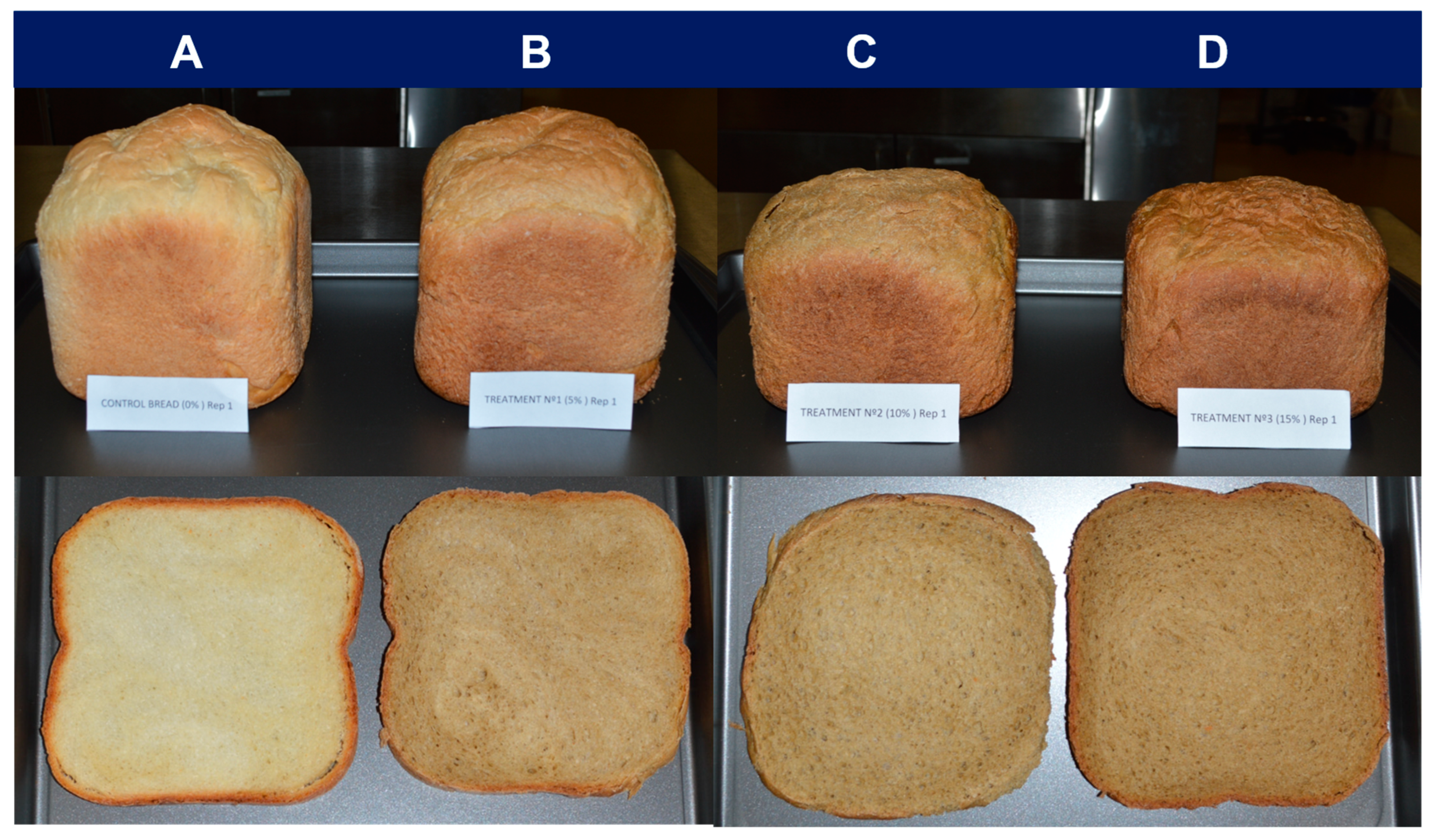
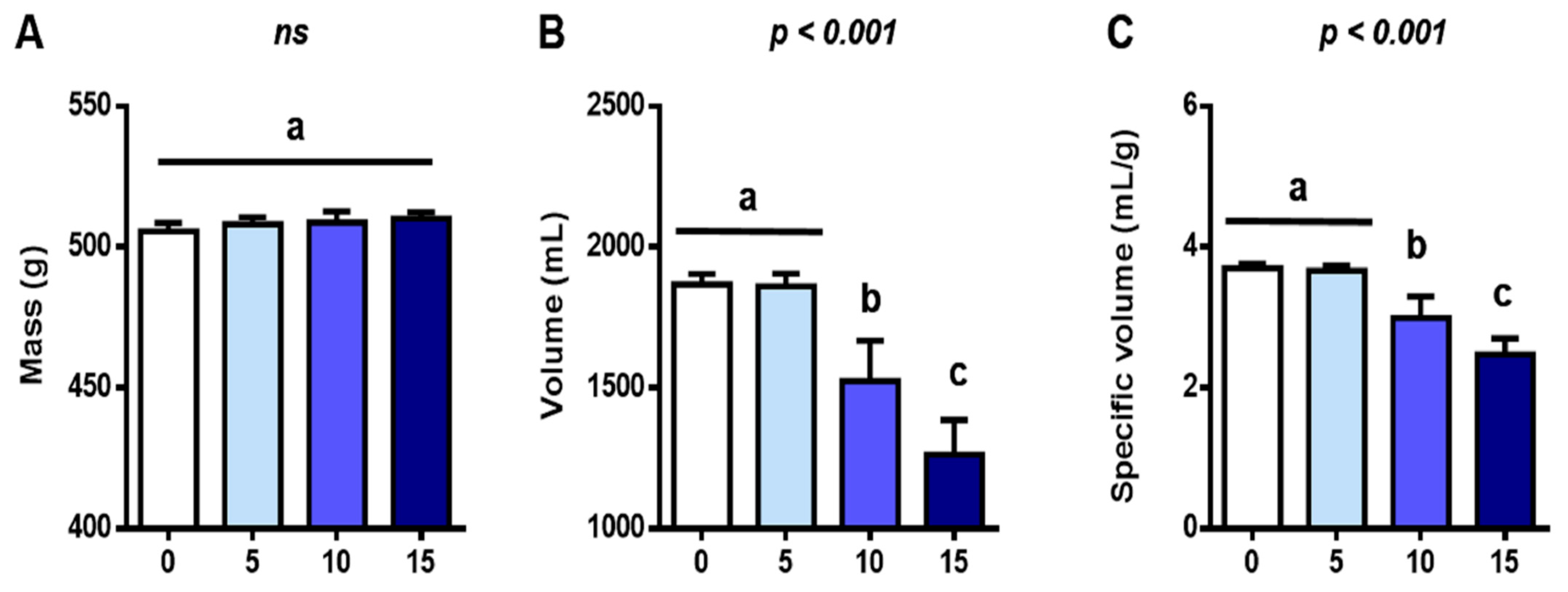
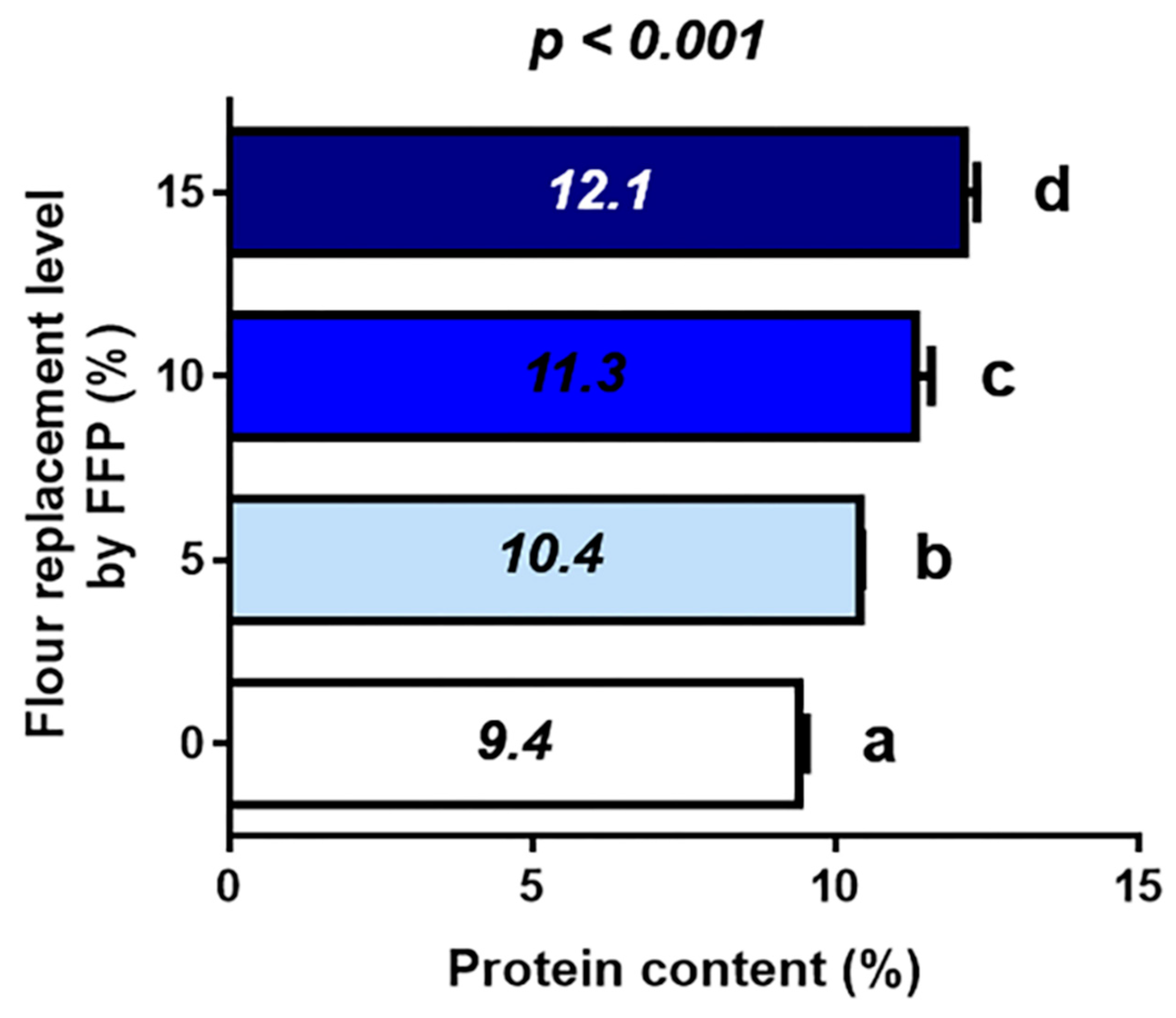
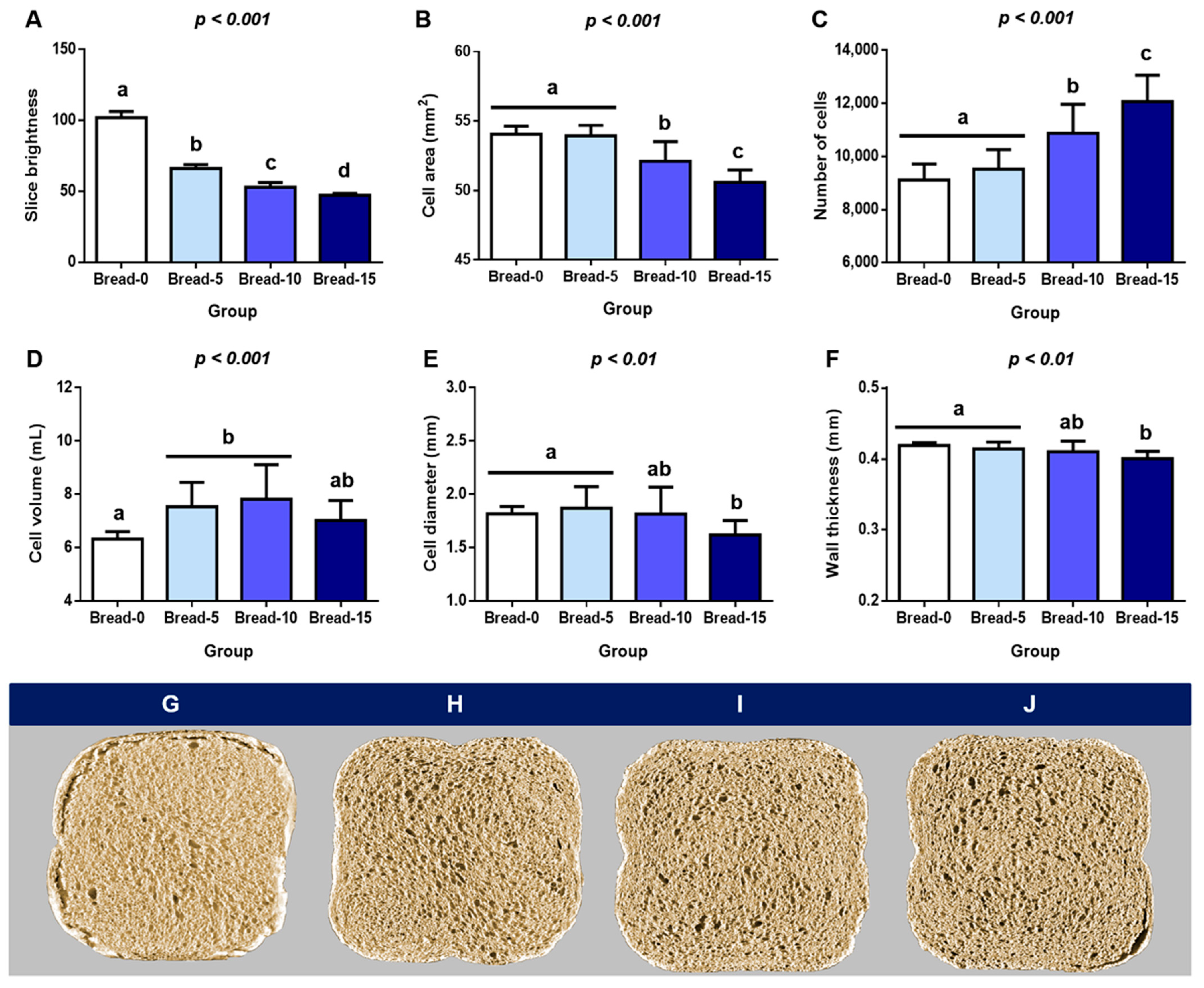
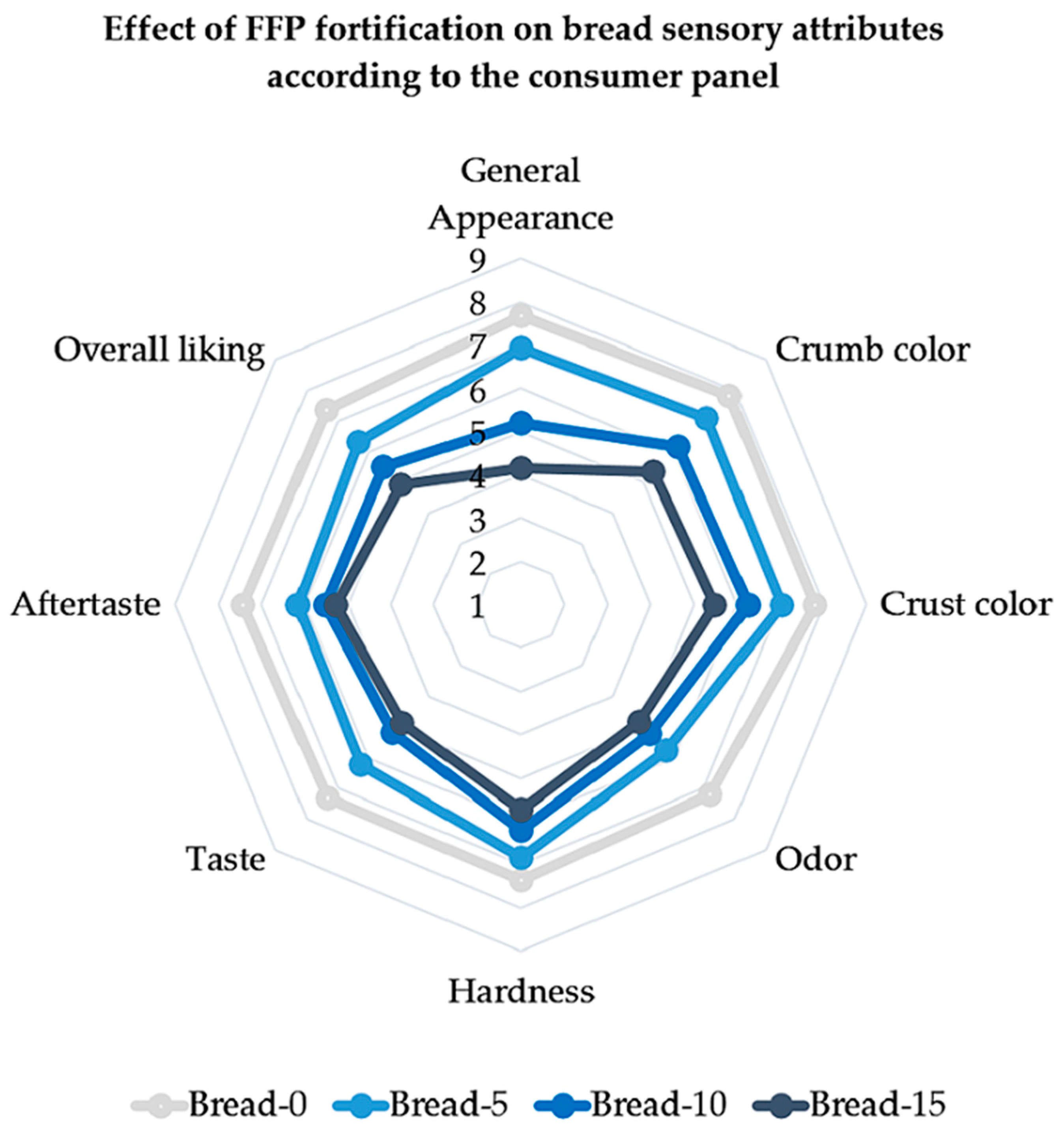
| Group | Ingredients (g) | ||||||
|---|---|---|---|---|---|---|---|
| Bread Flour | FFP | Sugar | Salt | Shortening | Activated Dry Yeast | Water | |
| Bread-0 | 100 | 0 | 5 | 2 | 5 | 3 | 56.51 |
| Bread-5 | 95 | 5 | 5 | 2 | 5 | 3 | 56.51 |
| Bread-10 | 90 | 10 | 5 | 2 | 5 | 3 | 56.51 |
| Bread-15 | 85 | 15 | 5 | 2 | 5 | 3 | 56.51 |
| Parameter | L* | a* | b* | |||||||
|---|---|---|---|---|---|---|---|---|---|---|
| Group | Mean | SD | p-Value | Mean | SD | p-Value | Mean | SD | p-Value | |
| Crust | Bread-0 | 52.5 a | 5.3 | p < 0.001 | 13.7 a | 1.3 | p < 0.001 | 27.9 a | 3.3 | p < 0.001 |
| Bread-5 | 46.1 b | 2.4 | 12.0 b | 0.4 | 23.8 b | 1.6 | ||||
| Bread-10 | 42.8 bc | 1.9 | 10.9 c | 0.2 | 21.1 c | 1.3 | ||||
| Bread-15 | 39.3 c | 1.5 | 10.4 c | 0.2 | 17.9 d | 1.2 | ||||
| Crumb | Bread-0 | 73.5 a | 1.1 | p < 0.001 | -1.2 a | 0.3 | p < 0.001 | 21.8 a | 0.7 | p = 0.001 |
| Bread-5 | 58.8 b | 1.3 | 2.2 b | 0.3 | 21.9 ab | 0.2 | ||||
| Bread-10 | 54.4 c | 2.3 | 3.1 b | 2.7 | 22.5 ab | 1.3 | ||||
| Bread-15 | 50.8 d | 1.2 | 2.9 b | 0.4 | 21.2 c | 0.4 | ||||
| Parameters | ||||||||||||
| General Appearance | Crumb Color | Crust Color | Odor | |||||||||
| Group | Mean | SD | p-Value | Mean | SD | p-Value | Mean | SD | p-Value | Mean | SD | p-Value |
| Bread-0 | 7.7 a | 1.4 | <0.001 | 7.8 a | 1.0 | <0.001 | 7.8 a | 1.0 | <0.001 | 7.2 a | 1.3 | <0.001 |
| Bread-5 | 6.9 b | 1.6 | 7.1 b | 1.6 | 7.0 b | 1.5 | 5.8 b | 1.8 | ||||
| Bread-10 | 5.2 b | 1.6 | 6.1 b | 1.4 | 6.3 bc | 1.4 | 5.2 b | 1.9 | ||||
| Bread-15 | 4.1 c | 1.8 | 5.3 c | 1.6 | 5.5 c | 1.6 | 4.8 b | 1.9 | ||||
| Hardness | Taste | Aftertaste | Overall Liking | |||||||||
| Group | Mean | SD | p-Value | Mean | SD | p-Value | Mean | SD | p-Value | Mean | SD | p-Value |
| Bread-0 | 7.4 a | 1.0 | <0.001 | 7.3 a | 1.2 | <0.001 | 7.4 a | 1.2 | <0.001 | 7.4 a | 1.1 | <0.001 |
| Bread-5 | 6.8 b | 1.3 | 6.2 b | 1.8 | 6.2 b | 1.8 | 6.3 b | 1.7 | ||||
| Bread-10 | 6.2 bc | 1.4 | 5.2 c | 1.9 | 5.5 b | 2.1 | 5.5 c | 1.6 | ||||
| Bread-15 | 5.7 c | 1.7 | 4.9 c | 2.1 | 5.3 b | 2.0 | 4.9 c | 1.8 | ||||
Disclaimer/Publisher’s Note: The statements, opinions and data contained in all publications are solely those of the individual author(s) and contributor(s) and not of MDPI and/or the editor(s). MDPI and/or the editor(s) disclaim responsibility for any injury to people or property resulting from any ideas, methods, instructions or products referred to in the content. |
© 2023 by the authors. Licensee MDPI, Basel, Switzerland. This article is an open access article distributed under the terms and conditions of the Creative Commons Attribution (CC BY) license (https://creativecommons.org/licenses/by/4.0/).
Share and Cite
Cabello-Olmo, M.; Krishnan, P.G.; Araña, M.; Oneca, M.; Díaz, J.V.; Barajas, M.; Rovai, M. Development, Analysis, and Sensory Evaluation of Improved Bread Fortified with a Plant-Based Fermented Food Product. Foods 2023, 12, 2817. https://doi.org/10.3390/foods12152817
Cabello-Olmo M, Krishnan PG, Araña M, Oneca M, Díaz JV, Barajas M, Rovai M. Development, Analysis, and Sensory Evaluation of Improved Bread Fortified with a Plant-Based Fermented Food Product. Foods. 2023; 12(15):2817. https://doi.org/10.3390/foods12152817
Chicago/Turabian StyleCabello-Olmo, Miriam, Padmanaban G. Krishnan, Miriam Araña, Maria Oneca, Jesús V. Díaz, Miguel Barajas, and Maristela Rovai. 2023. "Development, Analysis, and Sensory Evaluation of Improved Bread Fortified with a Plant-Based Fermented Food Product" Foods 12, no. 15: 2817. https://doi.org/10.3390/foods12152817
APA StyleCabello-Olmo, M., Krishnan, P. G., Araña, M., Oneca, M., Díaz, J. V., Barajas, M., & Rovai, M. (2023). Development, Analysis, and Sensory Evaluation of Improved Bread Fortified with a Plant-Based Fermented Food Product. Foods, 12(15), 2817. https://doi.org/10.3390/foods12152817







